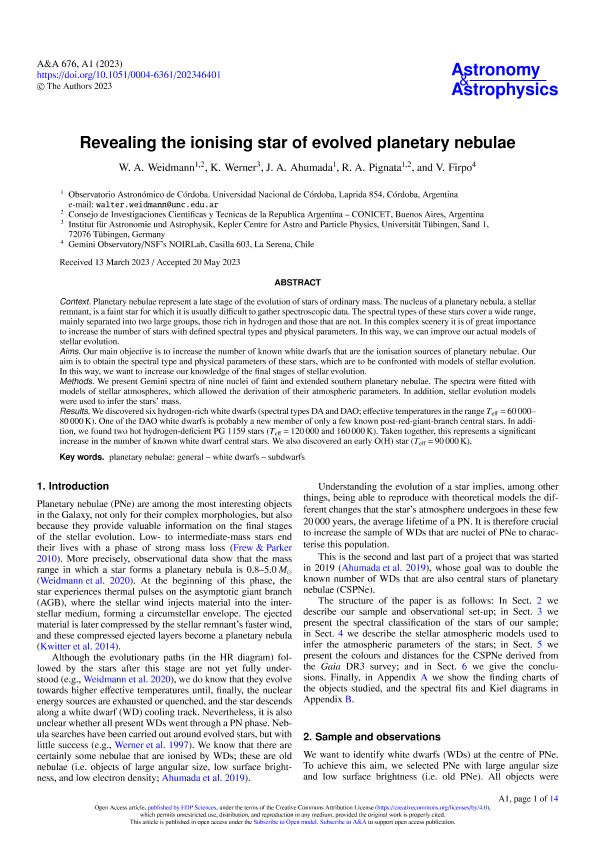Artículo
Revealing the ionising star of evolved planetary nebulae
Fecha de publicación:
07/2023
Editorial:
EDP Sciences
Revista:
Astronomy and Astrophysics
ISSN:
0004-6361
Idioma:
Inglés
Tipo de recurso:
Artículo publicado
Clasificación temática:
Resumen
Context. Planetary nebulae represent a late stage of the evolution of stars of ordinary mass. The nucleus of a planetary nebula, a stellar remnant, is a faint star for which it is usually difficult to gather spectroscopic data. The spectral types of these stars cover a wide range, mainly separated into two large groups, those rich in hydrogen and those that are not. In this complex scenery it is of great importance to increase the number of stars with defined spectral types and physical parameters. In this way, we can improve our actual models of stellar evolution. Aims. Our main objective is to increase the number of known white dwarfs that are the ionisation sources of planetary nebulae. Our aim is to obtain the spectral type and physical parameters of these stars, which are to be confronted with models of stellar evolution. In this way, we want to increase our knowledge of the final stages of stellar evolution. Methods. We present Gemini spectra of nine nuclei of faint and extended southern planetary nebulae. The spectra were fitted with models of stellar atmospheres, which allowed the derivation of their atmospheric parameters. In addition, stellar evolution models were used to infer the stars'mass. Results. We discovered six hydrogen-rich white dwarfs (spectral types DA and DAO; effective temperatures in the range Teff = 60 000- 80 000 K). One of the DAO white dwarfs is probably a new member of only a few known post-red-giant-branch central stars. In addition, we found two hot hydrogen-deficient PG 1159 stars (Teff = 120 000 and 160 000 K). Taken together, this represents a significant increase in the number of known white dwarf central stars. We also discovered an early O(H) star (Teff = 90 000 K).
Palabras clave:
PLANETARY NEBULAE: GENERAL
,
SUBDWARFS
,
WHITE DWARFS
Archivos asociados
Licencia
Identificadores
Colecciones
Articulos(CCT - CORDOBA)
Articulos de CTRO.CIENTIFICO TECNOL.CONICET - CORDOBA
Articulos de CTRO.CIENTIFICO TECNOL.CONICET - CORDOBA
Citación
Weidmann, Walter Alfredo; Werner, K; Ahumada, Javier Alejandro; Pignata, Rafael Andrés; Firpo, V.; Revealing the ionising star of evolved planetary nebulae; EDP Sciences; Astronomy and Astrophysics; 676; 7-2023; 1-14
Compartir
Altmétricas




